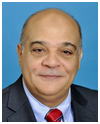Why are Non-Residential Consumers Key Enablers of Smart Grid?
By Ahmed R. Abdulaal, Ramin Moghaddass, and Shihab Asfour
The electricity demand is characterized by large and rapid fluctuations, mainly due to changes in human activities and/or natural causes. Hence, it requires constant vigilance to maintain grid stability for the day-to-day and intra-day operations. To sustain a resilient, safe, and reliable electric grid, demand fluctuation timing and magnitude must be accurately predicted and matched with equivalent supply power in real time. Therefore, suppliers today are constantly dispatching supply and predicting consumer demand, both of which are not fully reliable or predictable in nature. To mitigate the risks of demand fluctuations and supply availability, suppliers rely on driving the demand in the desired direction and volume by employing monetary incentives and penalties in the form of real-time pricing. An example of this type of market is demand response. The aim of this load-shifting incentives market is to reduce the uncertainties in the supply-demand equation as well as to avoid adding new generation plants. These efforts have been applied in many regions across the US with some success (for example during the 2010 snowstorms in the USA), however they may perform considerably more efficiently, if policymakers promote changes with a focus on non-residential consumers as the key enablers of a smarter, more resilient grid.
Deregulation of the US energy market, which commenced in the 1970s, created a structure for independent power producers and allowed multiple “retail” suppliers to coexist by competing for buying and selling electricity. Deregulation provided consumer flexibility in choosing their suppliers and supplier flexibility over their price. However, the actual results for the deregulated states proved some series defectiveness like high spikes in electricity prices and supply disruptions as in the famous California blackouts of 2000 and 2001. Despite these events, demand-side management (DSM) programs have become of great interest and continue to develop, especially as the electrification of the transportation sector and renewable energy investments continue to grow. In California alone, the level of renewable generation is expected to become 33% by 2020 and the state is preparing by increasing the reliance on DSM.
DSM includes financial incentives and educational efforts to drive the consumer-side demand fluctuations. These programs have had less-than-promised success for residential and small business sectors due to the following main reasons:
- Consumer Unpredictability: DSM relies on residential consumer responsiveness in an energy-aware conduct, which is not fully unachievable.
- Load Inflexibility: the degree of flexibility in scheduling residential-type loads is very low as most residential consumers are reluctant to reschedule their planned daily household operations, such as laundry and cooking.
- Human Behavior: for residential DSM to produce a sizeable impact, it must be aggregated across numerous consumers. This is difficult to attain because humans have very diverse behaviors and traditions affecting their consumption of power. Hence, the matter of responsiveness from end-customers, especially at small scales, is particularly challenging.
- Financial Reasoning: The high investment costs of effective home automation and communication systems are unjustifiable and the payback period is longer than several years. A 14 kWh battery, which can be utilized in storing and shifting energy in response to DSM signals, costs well over $10,000, while the average annual electricity costs are in the close $1,000 vicinity for a single home.
- Non-optimal Pricing: Almost all applied DSM programs suffer from the fact that the actual cost of energy is incurred after the energy is consumed, while the DSM price signal is communicated before that consumption would take place (i.e. on the expected/perceived value). This problem strikes the supplier-side with risks and leads to inefficient supply and demand bids.
To address the above problems with DSM, large investments would be required in intelligent automation tools, consumer education, policy changes, advanced smart-metering technologies, and other efforts. We discuss below that the non-residential sectors, particularly large manufacturers, offer greater opportunities for DSM without all the complexities and challenges of the residential sector:
- Independent Microgrids Opportunity: Large manufacturers have already utilized backup generators and storage systems capable of running at partial or full capacity independent of the grid to avoid outages during grid blackouts or even short service interruptions of service. Because this equipment is already on site, there is not much additional investment cost for such facilities to implement DSM. Such opportunities are partially utilized today by supplier programs like the Demand-Rider or Demand-Curtailment, which allow operators and/or aggregators to control a consumer’s generator in exchange for utility cost cuts. This opportunity can be further utilized by sharing the generation capacity across multiple consumers.
- Localized Generation Capacity: The large land capacity and facility roof of commercial consumers is sufficient for placing DERs, such as wind and solar, to support the local grid. One example of this today is a 1.4-megawatt solar array of 4,400 solar panels supporting the Florida Power and Light grid while providing shades for 400 parking spaces at the Florida International University. This establishment at a non-remote local commercial site supports peak mitigation on the local grid. Therefore, increased partnership between utility suppliers and large non-residential entities can facilitate the shift towards the microgrid and increase the utilization of renewables and the overall system reliability.
- Predictability: Consumption patterns and fluctuations for industrial consumers are highly predictable and almost constant throughout the season. The degree of predictability could be increased through sub-metering, where base loads (e.g., production equipment, refrigerators, computers) are separated from dynamic or controllable loads (e.g., HVAC, water heaters, decorative lightings). It has been an emerging trend of the R&D on DSM to identify specific load behaviors, in order to properly price the offered DSM programs. Adding meters at a step deeper in consumption would enhance considerably such efforts.
- Load-Flexibility: Various support-type loads exist in an industrial facility with a high degree of flexibility. Some examples are battery charging loads in electric forklifts, compressed air storage systems, and ice-banking.
- Sizeable Gains: Unlike the difficulty of tuning the aggregate DSM responses from thousands of residential consumers to the desired level, the demand measured at a single facility is relatively very large and thus investing in smart-communications, controls, and data analytics tools is more rewarding.
- Automation: Several large industrial facilities already utilize advanced building energy management systems (BEMS) or other building-integrated software for production-related process control and monitoring purposes. Currently, these tools are viable to the consumer for mitigating the amounts of energy wasted through inefficient practices with production equipment, in addition to maintenance and failure costs. These tools can also be upgraded to support building-to-grid-integration and increase the utilization of frequency regulation or other ancillary services.
In summary, it can be concluded that the grid modernization efforts can benefit widely from opportunities offered by industrial and large commercial consumers that together use 54% of the world’s total delivered electrical energy with annual growth of about 1.2%. This article argues that the focus of DSM should shift away from residential consumers due to several limitations, while more specific DSM policies for industrial consumers are encouraged. Furthermore, investments in smart buildings and BEMS are more opportune for the non-residential consumer than the residential consumer.
Contributors

Ahmed R. Abdulaal has conducted more than 80 energy audits to non-residential facilities in Florida and Puerto Rico and is experienced in energy data logging and analytics. His research work includes employing techniques from operations research, machine learning, and the development of optimization algorithms for complex problems in the smart grid environment. He will receive a Ph.D. in industrial engineering from the University of Miami in August 2017. He received a B.S. degree in mechanical design and production engineering from Cairo University, Egypt, in 2009, an M.S. in industrial engineering and an M.B.A from the University of New Haven, Connecticut, in 2012. He is currently a decision science professional Intern at the Walt Disney Company.

Ramin Moghaddass is an assistant professor with the Department of Industrial Engineering at the University of Miami Coral Gables, Florida. He is also the Assistant Director of the University of Miami’s Industrial Assessment Center (MIIAC), which is supported by the Department of Energy. His research centers around data analytics, stochastic modeling and optimization, and decision-making under uncertainty. Dr. Moghaddass received his Ph.D. from the Department of Mechanical Engineering at the University of Alberta, Edmonton, Canada, in 2008. He then spent two years at the Massachusetts Institute of Technology as a research fellow.

Shihab Asfour is Associate Dean for Academics at the College of Engineering and the Director of the Industrial Assessment Center of the University of Miami, Coral Gables, Florida. He served as the Chair of the Department of Industrial Engineering from 1999 until 2007. He holds the position of professor in the biomedical Engineering and the orthopedics and rehabilitation departments. He pioneered the application of ergonomics and biomechanics in the electric utility industry, and developed and implemented a large scale ergonomics program for the reduction of musculoskeletal injuries at Florida Power & Light Company (FPL). This work led to a major reduction of back injuries at FPL and contributed to FPL being the first US company to win the Deming Prize of Quality. Dr. Shihab Asfour has published over 250 articles in national and international journals, proceedings and books. His publications have appeared in the Ergonomics, Human Factors, Spine, and IIE journals. He has also edited a two-volume book titled "Trends in Ergonomics/Human Factors IV" published by Elsevier Science Publishers in 1987, and the book titled "Computer Aided Ergonomics," published by Taylor and Francis, 1990. Dr. Asfour received a Ph.D. in industrial engineering from Texas Tech University, Lubbock, Texas, in 1979.
To have the Bulletin delivered monthly to your inbox, join the IEEE Smart Grid Community.
Past Issues
To view archived articles, and issues, which deliver rich insight into the forces shaping the future of the smart grid. Older Bulletins (formerly eNewsletter) can be found here. To download full issues, visit the publications section of the IEEE Smart Grid Resource Center.




